I've been watching for these, and here is the first hairy little troll emerging!
Syneilesis aconitifolia, from seed in 2008:
Comments
Re: Syneilesis
Wonderful plant...I've had it around for years (going from garden to garden with me). My clump here is now 18 or so stalks. It is much further along than Lori's--already putting up buds. While the flowers are beautiful (at least when you get close), it is the early, felty growth pushing through the ground like some kind of green mushroom that is really the star.
Re: Syneilesis
Wonderful plant...I've had it around for years (going from garden to garden with me). My clump here is now 18 or so stalks. It is much further along than Lori's--already putting up buds. While the flowers are beautiful (at least when you get close), it is the early, felty growth pushing through the ground like some kind of green mushroom that is really the star.
Carlo, mine sounds like it's at a similar state as your plants, already showing flower stalks and the plants getting big. The best part of this plant is the spring foliage emergence. The plant gets fairly large, 18" (45 cm) tall or so, and spreading to 2' (60 cm) in 5-6 years.
For those who are curious, this is a small genus of Asian plants in the Asteraceae, related to Ligularia. It is available from a number of nurseries, here's the Plant Delights Nursery listing:
http://www.plantdelights.com/Catalog/Current/Detail/03400.html
Re: Syneilesis
I have tried this plant several times but you know, do I have to repeat? (The slugs of course.)
I haven't stopped trying so 6 seedlings wait to be big enough to be planted out!
Re: Syneilesis
I grew Syneilesis aconitifolia from seed in 2008 also. That summer, circumstances caused an overflow of my roof rain gutters, splashing water down on the seedlings. When I came home from work that evening, I found half of the soil washed out of all the pots, and the leaves supported by the convergence of root "stilts" at the crown. Yet almost every one survived.
Picture #2 is in 2009. Only a few plants produce more than one leaf that season. The single blue pot filled with round leaves is first year seedlings of Syneilesis intermedia.
Re: Syneilesis
1. Syneilesis aconitifolia on left (third season), Syneilesis intermedia on the right (second season). I am not sure if the upturned leaves of S. intermedia is indicative of the species or not. This is only their second season, and I have yet to have another year to compare. All is fine now, but at the time this pic was taken, they seemed a little peaked, like they are in pots to large for their size.
2. Another "treat" for buyers at our Society plant sale coming up.
Re: Syneilesis
1. Syneilesis aconitifolia on left (third season), Syneilesis intermedia on the right (second season). I am not sure if the upturned leaves of S. intermedia is indicative of the species or not. This is only their second season, and I have yet to have another year to compare. All is fine now, but at the time this pic was taken, they seemed a little peaked, like they are in pots to large for their size.
2. Another "treat" for buyers at our Society plant sale coming up.
Rick, you're like a one-man nursery :o :o :o Awesome seeing all those potted seedlings, once again I think all of us want to come to your NARGS chapter meetings! Not familiar with S. intermedia, but even in the young plants, I love the upswept pagoda arrangement of the leaves.
Re: Syneilesis
Well I wasn't kidding when I said I was a mad propagator. Anyone here is welcome at my house. I like to see the variation in species, so I like to grow many plants. I have both white flowering and pink flowering S. aconitifolia. Currently, I have Anemone rivularis growing from seed from several sources. (I just hope those sources didn't all get theirs from the same place.)
It's a lot of fun having a forest of miniature "palm trees" outside my kitchen window.
Syneilesis aconitifolia, still immature foliage.
Re: Syneilesis
Show me your Syneilesis aconitifolia flowers (or other Syneilesis species)! Actually, there isn't much to them, I usually cut off the stems, but left them on this year to remind myself why I cut them off.
A magnificent dry summer day here, 80 F (22 C), hypnotic strong breezes and occasional northwest gusts made getting photos difficult to focus. The flowering stems lean, they would be 3-1/2' (105 cm) tall if they stood straight, and the flowers.... eesh, just whitish things along the lines of a Prenanthes :P, the involucre stained dull lavender. I'll try to get a better photo if it's not so windy tomorrow. Rick, you mentioned your plants having "pink" flowers... let's see them.
Re: Syneilesis
I agree! The flowers are not much to beheld but without flower no seed!
I have planted out some of my seedlings and wonder if they are still alive when I get back home.
Re: Syneilesis
Rick, if you ever get seed......what a great sale you must have. Wish I could be there!
Re: Syneilesis
I should add, as negligible as the flowers are, they do have a sweet scent.
Re: Syneilesis
Mine haven't opened yet. Withholding a final judgment, but so far it looks like prenanthus is the better flower. Actually, we have a very nice wild pendant species that grows in the moist areas here.
Will see about seed, Todd. Although in the garden, one I planted did not flower, and the other, the flower stem broke off. Seed would be from woefully underpotted plants, and therefore may not be in the best of health. It is surprising, however, to observe the tenacity of the species under these adverse conditions.
Re: Syneilesis
Nothing to offer here re. flowering... I still have only single-leaf plants, but I'm pleased that both S. aconitifolia and S. palmata have made it through 2 winters now!
Re: Syneilesis
Nothing to offer here re. flowering... I still have only single-leaf plants, but I'm pleased that both S. aconitifolia and S. palmata have made it through 2 winters now!
Winters - no problem! Slugs are!!
Re: Syneilesis
Mine haven't opened yet. Withholding a final judgment, but so far it looks like prenanthus is the better flower. Actually, we have a very nice wild pendant species that grows in the moist areas here.
I have grown a couple "not too bad" Prenanthes species in the past, the nodding flowers on some are kind of "interesting". So, here's two much better photos of Syneilesis aconitifolia flowers today. The flowers opened more, and when adorned with "protruding bits" it is an amusing site at close hand, the sweet scent of the flowers wafting on this hot day (90 F, +32 C).
Re: Syneilesis
What a lovely plant! One to covet. Ordered seed from the Seedex last year but got something quite different that I'm still trying to identify. Will try again this year and hope I get the right seed this time. Did someone mention the flowers are pendant? One of the photos shows them on long stems that poke out (extrude?) beyond the leaf - unlike the Podophyllum peltatum it is often likened to. Fran
Frances Howey
London, Ontario, Canada
Zone 5b
Re: Syneilesis
My talk of pendant flowers was about Prenanthus spp. Syneilesis flowers are upright and do extend way above the foliage, as the previous pics show.
My plants are from the NARGS seed ex with seed collected in 2007. Every single seed germinated. They were winter sowed on February 3rd and left outside here in Minnesota. Most emerged April 18-25. Seedlings are curious things, as they produce only one leaf the entire first season, that is very different from the mature leaf form.
You can see in a previous pic here: http://nargs.org/smf/index.php?action=dlattach;topic=252.0;attach=4043;i... first year seedlings of Syneilesis intermedia in the lower left quadrant. S. aconitifolia seedlings look exactly the same.
Re: Syneilesis
Rick - if you are able to get such results from sowing seed outside in "winter" in your zone 4a, then it should work for my zone 5b too. Can hardly wait to try it that way. Guess the only way Syneilesis resembles Podophyllum peltatum is the way it emerges from the ground and then the umbrella leaves. Will check to see if they are the same family. Fran
Re: Syneilesis
Fran, rest assured that it, "winter sowing", (which seems to be the name currently applied to an age-old method, as though it's something new ;)) works in much colder zones than yours. The only real difference from "random" seed germination in nature is that one would usually control things somewhat by planting the seeds up in a pot, which may or may not be kept covered.
Re: Syneilesis
When I winter sow, I plant up the pots inside, water from the bottom, and then they drain uncovered for a day (or two if I don't get to the them) still inside. Then I enclose the pots in a clear plastic bag and put them out side. If temps are below zero F, I might put them in the garage for a few days first, before putting the outside.
Re: Syneilesis
Lori and Rick - Thanks so much for the info re sowing Syneilesis outside. Interesting to note that S. is a member of the Asteraceae family while Podophyllum is Berberidaceae.
Frances Howey
London, Ontario, Canada
Zone 5b
Re: Syneilesis
I have some seeds of S. aconitifolia to give away. Let me know if you're interested.
Re: Syneilesis
Interesting-- sort of Petasites meets Antennaria... Lori, where did you get seed? probably a seed-ex?
Re: Syneilesis
Hi, Cohan
Here are my records below... both are "easy, warm germinators":
Syneilesis aconitifolia NARGS 2008; #2905; garden - Started indoors Feb. 13/08; sprouted Feb. 18.
Syneilesis palmata Gardens North - Started indoors Feb. 9/08; sprouted Feb. 18.
Re: Syneilesis
Thanks, Lori. I didn't recall the name from Gardens North, but then, there is a lot to know on that list!
Re: Syneilesis
These plants are really showy upon leaf emergence. Here are two views taken the same morning recently, one before the sun was fully up, the second taken in morning sunshine, thus a different look. Syneilesis aconitifolia:
Re: Syneilesis
My Syneilesis spp. haven't even poked out of the ground yet!
Re: Syneilesis
The first furry little troll is finally emerging...
That's the cute stage... too bad they don't stay like that longer. ;)
Mine are jumping out of the ground; a photo from a few days ago:
Re: Syneilesis
My Syneilesis spp. haven't even poked out of the ground yet!
Then we are two, Rick! But of different reasons I assume. Here the slugs are the culprits :(
Re: Syneilesis
Ahhh, but they are up now, Trond. after giving some away and donating eight at the local Chapter sale (they sold for $6 and $7 for the white or pink flower forms), I still have many left. The one in the ground emerged a few days later, but is now farther along.
Re: Syneilesis
cute things ;D
Re: Syneilesis
Ahhh, but they are up now, Trond. after giving some away and donating eight at the local Chapter sale (they sold for $6 and $7 for the white or pink flower forms), I still have many left. The one in the ground emerged a few days later, but is now farther along.
I planted many seedlings last year and they grew well but I haven't seen anything to them this year :'( Two plants I had in pots were fine though and I have planted them out but I don't know how long they'll survive!
Re: Syneilesis
I do not know if anyone here grown it, but there is a beautiful form close to S.palmata
but, in my opinion, prettier and strong growing, S. aff. tagawae BSWJ11191 (it's a Crug Farm collected form).
She is quite tall, close to a meter, a very good plant.
Re: Syneilesis
Geoffrey, great seeing this one, even as an "aff." species, thanks for showing us this rarely seen species. Checking it out on The Plant List, S. tagawae is one of 6 accepted species, never heard of it before, I see that a synonym is Syneilesis aconitifolia var. tagawae, so perhaps it is closer to S. aconitifolia.
I have never visited the Crug Farm nursery list, oh my! Truly unique and intriguing plants, you're so lucky to have access to their offerings. I enjoy the small genus of Syneilesis, wonderful additions to the woodland garden; I have an eye out for seed of other species.
Re: Syneilesis
I have not grown S. palmata, but I was under the impression that it was the real beauty of the bunch. Your selection, Geoffrey, looks like a giant aconitifoilia, superficially at least. I didn't know such a species existed either. Would that be near meter high foliage or flower stalks?
Do you grow any of the other Syneilesis species? Is the culture any different for S. aff. tagawae?
I thought that accession designation looked familiar. Crûg Farm is the only place I have ever seen that has the real Lilium hansonii. (Everyone thinks hansonii is yellow, but it's not.) What a couple of very interesting (and learned) owners they must be!
Re: Syneilesis
I managed to buy some plants from Crûg Farm last month but I didn't dare to buy Syneilesis as all my beautiful plants were destroyed by slugs last year :'(
Re: Syneilesis
Maybe it's closer to aconitifolia yes. In fact, it's like a compromise between aconitifolia and palmata : when it emerge from the ground, the leaves are well divided as an aconitifolia but the division becomes larger as a palmata...
I grow Syneilesis aconitifolia, Syneilesis palmata and its selection 'Kikko', and this one, Syneilesis tagawae.
Syneilesis aconitifolia grows well here, but I have some difficulty with palmata, which is annualy attacked by slug which are legions in the garden, despite of my vigilance...And I think that they grow in an inappropriate place, too damp, almost wet. Because they enjoy high air humidity, but grow in soil just damp. So I have to move them this spring.
I love such "umbrella" plants as Dysosma and Podophyllum, and the slugs too...
So Syneilesis tagawae grow in light shade, damp soil, humiferous, with Podophyllum, Saruma, Epimedium etc.
Crug Farm is a mecca! Sue and Bleddyn are extremely friendly. I am fortunate to have a neighbor (Thierry Delabroye, always ^^), who is friends with them and multiplies some of their plants. I wish I could go at Crug as much as I want, but Wales is not so close! And a bit isolated...There are many other British nurseries, which are small wonders for me, like Nick Macer's one, Pan Global Plants in the Gloucestershire.
Re: Syneilesis
I love such "umbrella" plants as Dysosma and Podophyllum, and the slugs too...
So Syneilesis tagawae grow in light shade, damp soil, humiferous, with Podophyllum, Saruma, Epimedium etc.
Yes Geoffrey, there is something about "umbrella" leaved plants that adds intrique to the garden, I too like such plants. Do you grow Diphylleia cymosa? It's one of my favorites, great in the shady garden with adequate moisture; since I grow mine in average to at times dryish soil, it stays much smaller and manageable in such conditions, growing massive in a wet boggy situation. The mottled brownish color of the spring leaves is a definite attraction, as are the expanding leaves, flowers, and berries.
http://nargs.org/smf/index.php?topic=253.0
I noticed Saruma henryi in some of your Epimedium photos, another of my favorite woodland plants, it is starting to seed around quite a bit too.
Re: Syneilesis
I must admit that I have great difficulties with Diphylleia cymosa...
I do not know exactly why...
It didn't seem to enjoy the garden soil, can be too clayey...And slugs do great damages also.
In the garden of a friend in Belgium, the Diphylleia are monstrous, wealthy, it is a magnificent spectacle.
I'd have to try it somewhere else, but usually, after a failure, I'm a bit "chilly" (I don't know if this expression exists in English ^^) to try again...
Saruma henryi is one of my favorite plants in the woodland yes. A very easy plant which has the merit of naturalizing and whose flower color is the one I prefer at this time.
There's a scene in the garden that takes me to heaven every year, the Epimedium 'Flowers of Sulphur' surrounded by Saruma henryi with Paris quadrifolia and polyphylla and Polygonatum yunnanense, lined with and Selaginella sanguinolenta and kraussiana.
I love the Aristolochiaceae, I try to cultivate some Aristolochia here, as A.tomentosa, A.macrophylla, A.debilis, or A.clematitis A.mandschurica. My friend Mark Brown has a small collection.
Re: Syneilesis
Paris is a genus that I would love to try, fascinating plants, but seldom ever offered here. Trying to get a few more Polygonatums introduced in the garden, I have failed with some that I've tried. You mentioned in a previous message the genus Chloranthus, one that I first encountered at Darrell Probst's nursery, utterly unique and charming plants; I must beg a piece from Darrell sometime.
Re: Syneilesis
Paris are amazing plants, some are really impressive. I do grow a few here, Paris quadrifolia, which is common in parts of France, Paris polyphylla, Paris polyphylla yunnanensis alba, Paris japonica and Paris vietnamensis, but there are many other equally ornamental. (look at these pictures : http://www.greenmilenursery.be/photo_paris.html at Robin Callens's nursery in Belgium)
For Chloranthus, I was especially interested in them through Mark Brown (whose garden is based on an demential project retracing the evolution of flowering plants), because the Chloranthaceae are a very old family, phylogenetically speaking, almost fossils.
By cons, they are very slow to expand, their only fault! ^ ^
Re: Syneilesis
I mean Syneilesis palmata is one of the best woodland plants and there are several Japanese forms. They come up early and still where we can get frost at night, but it seem that they not get any damaged.
Re: Syneilesis
I mean Syneilesis palmata is one of the best woodland plants and there are several Japanese forms. They come up early and still where we can get frost at night, but it seem that they not get any damaged.
I would love to grow them but the slugs have damaged them every time I have tried :'( Maybe they tolerate frost but not slugs >:(
Re: Syneilesis
I mean Syneilesis palmata is one of the best woodland plants and there are several Japanese forms. They come up early and still where we can get frost at night, but it seem that they not get any damaged.
I would love to grow them but the slugs have damaged them every time I have tried :'( Maybe they tolerate frost but not slugs >:(
Indeed, here too slus are public enemy number one, a constant struggle...
Karl, your selections are superb, I grow 'Kikko here, but in pots, precisely because of the slugs ...
I love your site, since a long time, bravo!
Re: Syneilesis
I mean Syneilesis palmata is one of the best woodland plants and there are several Japanese forms. They come up early and still where we can get frost at night, but it seem that they not get any damaged.
Karl, those Syneilesis are the epitome of horticultural whimsy, just fantastic, and I'm totally smitten with what you show. Are these generally available in Europe? I assume these all come out of Japan, did you import them or obtain them from a European nursery?
Slugs are no problem here in my dryish New England garden, so I suspect if these whimsical Syneilesis were to become available here, they should grow just fine in our climate. Thanks for showing these wonders.
Karl, in your experience, do these varieties come true from seed, or do seed-grown plants offer lots of variability?
Re: Syneilesis
Very interesting, Karl! I will be happy to hear the answers to Mark's questions....
Does anyone know what the Japanese growers are doing to get so many variegates and other forms? Is it simply sowing thousands to find the one sport? Or do they have some techniques to speed mutations?
Re: Syneilesis
No they are very rare in Europe and I got them from a Japanese friend. About the varieties forms of Japanese plants I think it is because they are very good plants man and they got lot of material in the nature, as you also see in Trillium in US and we see in our nature plants.
Syneilesis belongs to Asteraceae family and my wife and I have sown several plants from that family before and with luck, but we have any luck with Syneilesis I don’t know why. I have divided a few of them and then I also know they are right.
Re: Syneilesis
I ask because I look at a lot of plants in nature, and we have many species here that are very very common, so I see thousands of them in a season- and never any variegates! I've seen one small willow/Salix in nature, that seemed to be variegated, and that is the only thing! The Syneilesis makes me think of our native Petasites palmatum -very nice leaves, woodland plant, and very very common, the leaves are everywhere in our woodland- I have never seen a variegated leaf......
Re: Syneilesis
It only takes finding one mutation to be propagated and spread around the world, Cohan. I don't think your observations are abnormal. Of course, some species seem to be more prone to variegation or other mutations than others. Even certain populations or areas of the same species can be discovered to mutated more "commonly" than others. For instance, a disproportionate amount of dwarf and otherwise interesting forms of Canada hemlock (tree) are found in the northeast U.S.
Re: Syneilesis
With the current heat wave, plants are jumping out of the ground. Syneilesis aconitifolia appeared a couple days ago, with the umbrellas leaves opening up today... they're so cute.
Re: Syneilesis
Mark, that's why you wouldn't have slug problems even with lots of slugs. The plants grow too quickly.
Very cute, I agree!
Re: Syneilesis
Trond, too dry for slugs here in this garden, I only ever see them when we have long bouts of rainy weather. There's a place down the street that has small wetlands on one side, and sometimes in the mornings slugs will attempt to cross the street, but since they're so slow, by the time the sun rises and starts baking the pavement, there is a mass slug-drying ;D I see this when I run around the neighborhood, and I have to gingerly step to avoid treading on drying slugs. It's a fine sight indeed.
Re: Syneilesis
Mark, yours are at about the same stage as mine in pots. Mine in the garden on the north side of the house have not emerged yet. S. intermedia in pots are only an inch high.
Syneilesis aconitifolia
Re: Syneilesis
Today I attended our NARGS New England Chapter annual meeting and rare plant auction, and on this chilly start of a sunny new day, the event was well attended (about 40 people) and there were some very desirable one-of-a-kind plant offerings for auction. I set my eyes on Syneilesis palmata 'Kikko'. It was mentioned that the local nurseryman who imported this plant from Japan spent $200 for it. Bidding was spirited but I prevailed with the Syneilesis, which as it turns out, cost me the same as the Plant Delights Nursery price:
http://www.plantdelights.com/Syneilesis-palmata-Kikko-Kikko-Shredded-Umb...
I donated a nice looking plant of S. aconitifolia, which went for around $30. Rick, a few of your S. intermedia plants would have raised a handsome sum and increased the chapter's coffers.
Syneilesis palmata 'Kikko', the net-variegated plant in the top-center: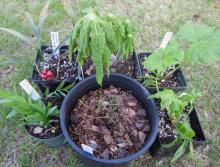
Re: Syneilesis
That must be one of those plants that become more variegated as the leaves mature. I grew a variegated forsythia (Forsythia 'Kumson') that did that. I planted seed from Syneilesis palmata 'Kikko' from the NARGS seed ex. The first one emerged a few days ago. ;D It's hardly done anything since it has been so cold this last week.
My Syneilesis aconitifolia are just coming up in the garden now (among our native Thalictrum thalictroides), but ones in pots have been growing for a while already.
Re: Syneilesis
I planted seed from Syneilesis palmata 'Kikko' from the NARGS seed ex. The first one emerged a few days ago. ;D
My Syneilesis aconitifolia are just coming up in the garden now, but one in pots have been growing for a while already.
I must have missed Syneilesis palmata 'Kikko' from the NARGS seed ex. I was talking with NARGS members about S. aconitifolia and they mentioned that they never get viable seed. Last year, I collected lots of seed, but never donated nor sowed the seed :rolleyes:, so it's hard for me to comment, so now I wonder about seed viability of this species.
Please show us see your results with the very-variegated 'Kikko' seedlings once they develop. Does Syneilesis have some attraction at your local NARGS meeting plant sales, I would think they must be popular.
Re: Syneilesis
From my first plantings, which were also from the NARGS seed ex, the donated seed was extremely viable - near 100% germination. I winter sowed them in pots in late January. I had so many that I probably threw out half of them!
Since Syneilesis only puts up one non-true leaf the first year, I wonder if variegation would show on any of the Kikko seedlings the first year. We'll have to see....
Re: Syneilesis
Syneilesis palmata 'Kikko' (foreground) is feeling right at home planted close to its neighbor, A. aconitifolia (background). :D
Re: Syneilesis
The pink flowering form of Syneilesis aconitifolia (Shredded umbrella Plant) is maturing in the garden now, and I never thought the leaves would get this large! I refuse to be slave to my gardens, so they wilt down a little every day in this heat to the point that they now look permanently wilted, even though they can be fully turgid. (Unfortunately, I don't have any constantly moist garden areas.) The photo is deceiving, but laid flat, the largest leaf measures 19.5 inches across!
Re: Syneilesis
An impressive beauty there Rick. Looks great given enough room to breathe. I planted my Syneilesis palmata 'Kikko' much too close to other plants, and it is totally hidden by Kirengeshoma palmata right now, but I plan to move it to a more generous spot. The pink flowers on your Syneilesis aconitifolia look rather showy, and the reflexed leaf form is most appealing.
Re: Syneilesis
What a fascinating plant Rick - those 'shaving brush' like flowerheads are intriguing, and the close up of the flowers rather striking. Like all the ligularias I think we would struggle with this in our summer dry garden.
Re: Syneilesis
Really great looking plant, Rick! this is something I'd love to try for sure :)
On the wilting, I have a planting of one of the native tall Antennaria species (I've keyed it, but forget now, need to do it again now that I have photos of this year's involucres which hold the important characters) which usually grows in moist areas and while the soil where it is does not ever dry out, it does tend to droop a bit in the leaf, which I think cannot be about moisture- the place I collected it from originally is no wetter than where it is now.. so I'm not sure if this is just normal ( I don't see the wild plants consistently enough to see if they droop) or if it has anything to do with the fact that in nature the plant is much less concentrated- the plant spreads by stolons, but they are mixed with other plants in nature, in my garden it's a tight clump, and or maybe more shading from those plants they are mixed with in nature, though they are in locations as open as mine or often more so... anyway, doesn't seem to hurt it- no leaf browning, and it's flowering and growing..
Re: Syneilesis
A great Syneilesis, Rick! All my attempts to grow that genus have failed (slugs of course) but I am tempted to try at my summerhouse where the slug problem is less (but drought is more frequent :-\).
Re: Syneilesis
This is the fifth season planted in the garden for Syneilesis aconitifolia. I am certainly not complaining, but had expected it to wander more and take up more real estate. To my delight, it is staying quite compact! Does it just need more time?
Re: Syneilesis
This is the fifth season planted in the garden for Syneilesis aconitifolia. I am certainly not complaining, but had expected it to wander more and take up more real estate. To my delight, it is staying quite compact! Does it just need more time?
I'm finding it quite slow here, Rick - but perhaps, long-term, that's a good thing.
It is slow to emerge, to enlarge and also to spread - obviously not in any hurry at all!
Maggi
Re: Syneilesis
Rick, do you have two forms of S. aconitifolia, one that is the typical whitish form, and the pink flowered form you showed us last year? I'd like to get hold of a second clone sometime, particularly one with pink flowers, maybe a seed swap in the future?
Re: Syneilesis
Lovely Syneilesis, Rick! My problem is that no plant even last a single season :( (Slugs, if you didn't guess)
Re: Syneilesis
This is the fifth season planted in the garden for Syneilesis aconitifolia. I am certainly not complaining, but had expected it to wander more and take up more real estate. To my delight, it is staying quite compact! Does it just need more time?
Looks wonderful, Rick. Plant Delights says "spreading slowly", "2 feet wide in 5-7 years".
Re: Syneilesis
Looks wonderful, Rick. Plant Delights says "spreading slowly", "2 feet wide in 5-7 years".
Oh gee.... I just assumed it spread like Mark's from the get go:
http://nargs.org/smf/index.php?topic=252.msg16721#msg16721
Mark, yes I have the white and pink flowering forms of S. aconitifolia. Last year, the seed heads looked so promising (I only let the pink ones form), but every "seed" was empty. I know I had saved some anyway to plant, but darned if I can find them. ??? Now that I know (maybe) that they seem to be self infertile, I'll make a point to cross pollinate the seedlings I have. Flower stems are already forming on the one pictured above (a pink flowering one).
I finally planted Syneilesis intermedia in the garden last week.
Rick, are your Syneilesis
Rick, are your Syneilesis plants getting ready to flower? Mine are, and I just noticed that the buds are indeed tipped pink on the outside, although the flowers will be white.
Mine aren't quite that far
Mine aren't quite that far along, althiugh it is really surprising how close in development they are to yours, considering they are on the the north side of my house and only a foot (approx) outside the roof eve. Initially, our spring here in zone 4 Minnesota was a full month late, but we have almost caught up to a normal season already. This is another weird season for us, and many species are blooming out of their normal comparative sequence. This is the pink form of Syneilesis aconitifolia, pic taken tonight.

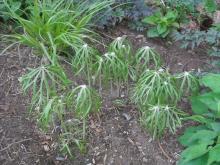
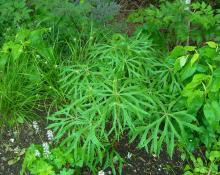
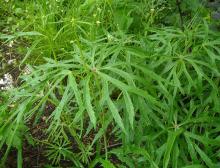
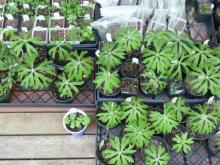

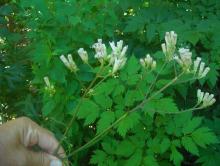
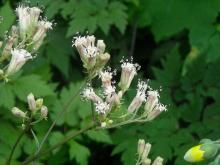
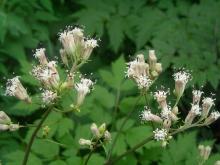
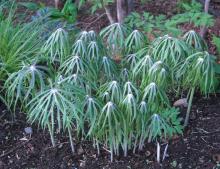
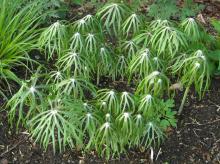
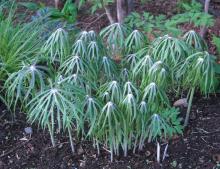
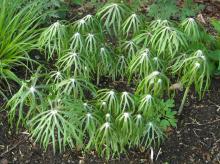
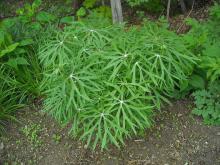
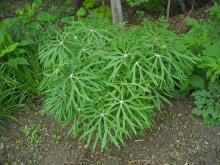
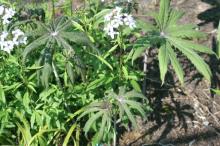
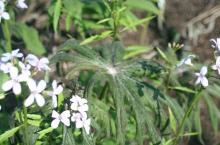
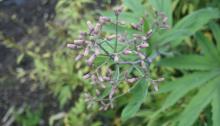
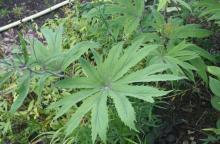
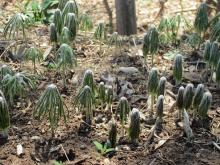
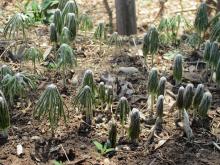
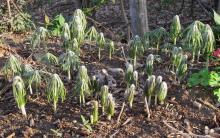
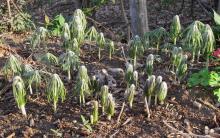
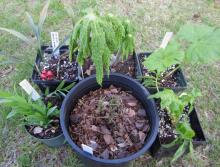
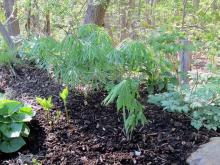

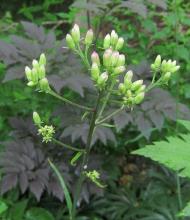
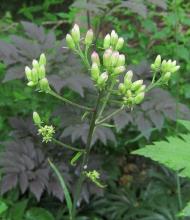
Funky! I've never tried them.